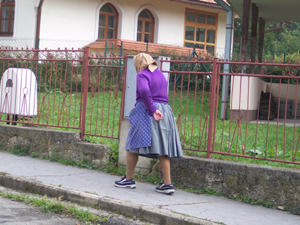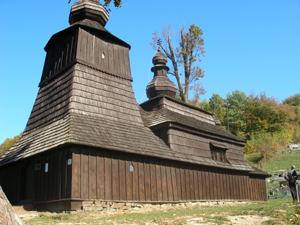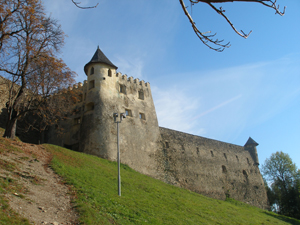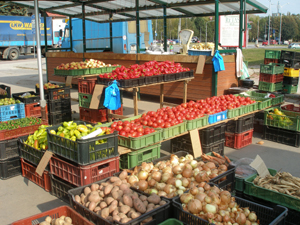Our plan for this trip was to learn about the Slovak ancestry of our
grandchildren. We had learned the names and locations of several
 A resident of a small village
villages in the eastern part of the country which produced the immigrants
who founded American branches of the Hopko, Jurus and Links
families. Before the trip, we had prepared scrapbooks containing photos
of those families -- whatever old family photos we had, plus photos of the
living American relatives, so that if we did find relatives, we could show
them their American cousins.
A resident of a small village
villages in the eastern part of the country which produced the immigrants
who founded American branches of the Hopko, Jurus and Links
families. Before the trip, we had prepared scrapbooks containing photos
of those families -- whatever old family photos we had, plus photos of the
living American relatives, so that if we did find relatives, we could show
them their American cousins.
We had no idea that our plan would succeed so well. Despite major
difficulties with language, we were able to make contact and have friendly
visits in several villages.
 Inside a Greek Catholic cathedral
We learned that the Catholic religion -- Roman,
Greek or Byzantine Catholic -- is an integral part of the life of most
Slovaks. We saw ancient castles and modern cities, and many museums which
taught us that this area has a very long and rich history. And we learned
about an ethnic group which were probably some of our more distant ancestors
-- a people the Polish call Lemko, but known in Slovakia as Carpatho-Rusyns.
Inside a Greek Catholic cathedral
We learned that the Catholic religion -- Roman,
Greek or Byzantine Catholic -- is an integral part of the life of most
Slovaks. We saw ancient castles and modern cities, and many museums which
taught us that this area has a very long and rich history. And we learned
about an ethnic group which were probably some of our more distant ancestors
-- a people the Polish call Lemko, but known in Slovakia as Carpatho-Rusyns.
We were a group of four: Bob and Elsa, plus cousins Marilyn and Tom, who are also
descended from Slovak and Polish families. Coming from different airports,
we met in Bratislava, did some sightseeing while we recovered from jet lag,
and then drove across the country to the area near Presov,
 One of the ancient wooden churches
where we stayed
for nine days, with excursions to Poland, meeting relatives and learning a
great deal more about our family history. Then we turned west, to Martin,
near the center of the country, learning about the region from which some
Jewish ancestors originated. We finished our trip with three more days in
Bratislava, where we met more relatives and explored quite a few museums
and city attractions.
One of the ancient wooden churches
where we stayed
for nine days, with excursions to Poland, meeting relatives and learning a
great deal more about our family history. Then we turned west, to Martin,
near the center of the country, learning about the region from which some
Jewish ancestors originated. We finished our trip with three more days in
Bratislava, where we met more relatives and explored quite a few museums
and city attractions.
Driving in Slovakia was part of the adventure. Some drivers drove over 130 km per hour
on open country roads, even though the speed limit was 90 and the roads had just two
lanes with no shoulders. Perhaps the drivers engaged in wishful thinking,
hoping that the roads between towns were actually motorways -- which, in fact,
were rapidly being constructed. We witnessed numerous dangerous maneuvers,
 Stará L'ubovn'a castle
and learned of the deaths of family members in three separate highway accidents.
With all that, a cautious driver could enjoy driving in Slovakia, although some
general familiarity with European driving would help.
Stará L'ubovn'a castle
and learned of the deaths of family members in three separate highway accidents.
With all that, a cautious driver could enjoy driving in Slovakia, although some
general familiarity with European driving would help.
Trains connect the major cities, but they did not look too inviting, and
in any case the most charming sights and experiences were in the small villages
where there was no train service. On the other hand, the trains and buses are
reliable and inexpensive, and would be suitable for younger adventurers.
This was an exceptionally fortunate trip -- we were lucky in our genealogical
work, lucky in sightseeing, and lucky in the weather, which could have been
cold and rainy, but instead gave us nearly two weeks of uninterrupted mild sunny
autumn weather, in the range of 40 to 65 degrees (Fahrenheit).
 A produce market in Martin
The language barrier was less serious than we feared, but for an unexpected
reason -- the people would go out of their way to try to communicate, and there
always seemed to be an English-speaker willing to lend a hand (although once we
had a conversation in German just to be understood). We were grateful we had
spent a year struggling with a Slovak language course, and equally grateful
that we carried our dictionary so we could slowly write out sentences in Slovak.
A produce market in Martin
The language barrier was less serious than we feared, but for an unexpected
reason -- the people would go out of their way to try to communicate, and there
always seemed to be an English-speaker willing to lend a hand (although once we
had a conversation in German just to be understood). We were grateful we had
spent a year struggling with a Slovak language course, and equally grateful
that we carried our dictionary so we could slowly write out sentences in Slovak.
For American visitors, Slovakia is remarkably inexpensive, especially the food.
This made it possible for us to sample a variety of restaurants and select
hotels without worrying about cost.
Eastern Europe, it seems to us, has all the technological savvy of a Western
country, but needs to catch up after decades of state-run economies. This is
happening rapidly, although the Eastern Europeans we met still complain of
losing young workers to Ireland and England, and occasionally America. The
good news is that they are all planning to return, and we have no doubt that
the Eastern Europe of 2020 will be like the Western Europe of 2000 --
sophisticated and comfortable.
All in all, it was a joyous intense experience, and we hope that the more
detailed reports to follow will communicate some of our happy discoveries.
 A resident of a small village
villages in the eastern part of the country which produced the immigrants
who founded American branches of the Hopko, Jurus and Links
families. Before the trip, we had prepared scrapbooks containing photos
of those families -- whatever old family photos we had, plus photos of the
living American relatives, so that if we did find relatives, we could show
them their American cousins.
A resident of a small village
villages in the eastern part of the country which produced the immigrants
who founded American branches of the Hopko, Jurus and Links
families. Before the trip, we had prepared scrapbooks containing photos
of those families -- whatever old family photos we had, plus photos of the
living American relatives, so that if we did find relatives, we could show
them their American cousins.
 Inside a Greek Catholic cathedral
Inside a Greek Catholic cathedral One of the ancient wooden churches
One of the ancient wooden churches Stará L'ubovn'a castle
Stará L'ubovn'a castle A produce market in Martin
A produce market in Martin